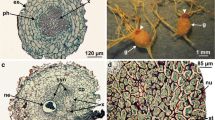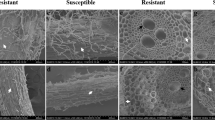Abstract
Root-knot nematodes (RKNs) (Meloidogyne spp.) are one of the most damaging crop pests and cause severe yield losses worldwide. Easier and more efficient methods are needed for assessing nematode infestations and host plant resistance. In the present study, we combined toluidine blue staining and paraffin sectioning to observe the establishment of giant cells (GCs; redifferentiated cells induced by nematode feeding) and the developmental status of RKNs in tomato (Solanum lycopersicum). The number of RKNs was counted using a modified freeze-thaw counting method. Finally, three tomato lines with different levels of RKN resistance, but otherwise identical genetic backgrounds, were tested to verify the applicability of the combined method. The results suggested that using toluidine blue staining combined with paraffin sectioning and freeze-thaw counting accurately reflects the level of RKN resistance of tomato plants.
Similar content being viewed by others
References
Abad P, Gouzy J, Aury JM, Castagnone-Sereno P, Danchin EG, Deleury E, Perfus-Barbeoch L, Anthouard V, Artiguenave F, et al (2008) Genome sequence of the metazoan plant-parasitic nematode Meloidogyne incognita. Nat Biotechnol 26:909–15
Absmanner B, Stadler R, Hammes UZ (2013) Phloem development in nematode-induced feeding sites: the implications of auxin and cytokinin. Front Plant Sci 4:241
Bhattarai KK, Xie QG, Mantelin S, Bishnoi U, Girke T, Navarre DA, Kaloshian I (2008) Tomato susceptibility to root-knot nematodes requires an intact jasmonic acid signaling pathway. Mol Plant Microbe Interact 21:1205–1214
Bird AF (1961) The ultrastructure and histochemistry of a nematodeinduced giant cell. J Biophys Biochem Cytol 11:701–715
Bybd DW, Kirkpatrick T, Barker KR (1983) An improved technique for clearing and staining plant tissues for detection of nematodes. J Nematol 15:142–143
Chen LJ, Wang X, Duan YX, Sun XM (2007) Extraction effectiveness of soil nematodes with sucrose-centrifugation method. J Shenyang Agric Univ 38:849–851
Chen XF, Xiao K, Zhu X, Chen WY, Yang Y, Hu JF (2015) Development of giant cells and roles of CCS52B gene work in Meloidogyne incognita resistant Prunus sogdiana. Acta Hortic Sin 42:843–852
Cooper WL, Jia L, Goggin L (2005) Effects of jasmonate-induced defenses on root-knot nematode infection of resistant and susceptible tomato cultivars. J Chem Ecol 31:1953–1967
Endo BY (1965) Histological Responses of Resistant and Susceptible Soybean Varieties and Backcross Progeny to Entry and Development of Heterodera glycines. Phytopathology 55:375–381
Fan JW, Hu CL, Zhang LN, Li ZL, Zhao FK, Wang SH (2016) Jasmonic Acid Mediates Tomato’s Response to Root Knot Nematodes. J Plant Growth Regul 35:301–302
Fujimoto T, Tomitaka Y, Abe H, Tsuda S, Futai K, Mizukubo T (2011) Expression profile of jasmonic acid-induced genes and the induced resistance against the root-knot nematode (Meloidogyne incognita) in tomato plants (Solanum lycopersicum) after foliar treatment with methyl jasmonate. J Plant Physiol 168:1084–1097
Germani G, Plenchette C (2005) Potential of Crotalaria species as green manure crops for the management of pathogenic nematodes and beneficial mycorrhizal fungi. Plant Soil 266:333–342
Guo CH, Lv H, Liu L, et al (2016) Population diversity of nematodes in Glycyrrhiza uralensis rhizosphere soil in Jiuquan, Gansu Province. J Plant Prote 42:128–132
Li HP (2009) Purpose and methods of the plant production overview, in Li HP, Plant microscopy techniques, Ed 2, science press, Beijing, pp 2–8
Li HY, Wang LR, Cao K, et al (2015) Histopathological of the early interactions between peach roots and Meloidogyne incognita. Acta Hortic Sin 42:1040–1048
Huang JL, Lu XH, Gao LL, Wan YL, Liu ZM (2015) Identification of root-rot nematode from Chinese yam in Guangxi, China. Guangxi Agric Sci 46:1990–1993
Khallouk S, Voisin R, Van Ghelder C, Engler G, Amiri S, Esmenjaud D (2011) Histological mechanisms of the resistance conferred by the Ma gene against Meloidogyne incognita in Prunus spp.. Phytopathology 101:945–951
Kyndt T, Goverse A, Haegeman A, Warmerdam S, Wanjau C, Jahani M, Engler G, de Almeida Engler J, Gheysen G (2016) Redirection of auxin flow in Arabidopsis thaliana roots after infection by root-knot nematodes. J Exp Bot 67:4559–4570
Mcbeth CW, Taylor AL, Smith AL (1941) Note on staining nematodes in root tissues. Proc Helminthol Soc Wash 8:26
Wang Z, Liu QZ, Zhou HY, et al (2011) Suppression mechanism of Meloidogyn incognita infection on cucumber by soil amendments. China Veget 1:16–22
Ruan WB, Zhan LL, Wei X, Chen S (2012) An improved method for quantification of Heterodera glycines in plant tissues. Nematropica 42:237–244
Wang G, Shen YH, Wang JF, et al (2006) Histopathological change of different tobacco varieties infected by Meloidogyn incognita. J Henan Agric Sci 27:20–22
Ye DY, Wang X, Zhang YX, Qian CT, Chen JF (2010) Anatomy and cytology of sour cucumber for its resistance to the root-knot nematode Meloidogyne incognita. Acta Phytophy Sin 40:495–503
Zhang H, Xiao H, Zhang JH, Peng SS, Zhou ZH (2013) Microstructure and distribution of toluidine blue staining positive cells of small intestine from Ningdu yellow chicken. Chin J Veterinary Sci 33:1064–1068
Author information
Authors and Affiliations
Corresponding author
Electronic supplementary material
Supplementary Fig. 1.
Paraffin section of root tissue (10X magnification). A: safranine staining for eight hours; B: Safranine staining for twenty-four hours.
Rights and permissions
About this article
Cite this article
Li, X., Zhao, W., Zhou, X. et al. The use of toluidine blue staining combined with paraffin sectioning and the optimization of freeze-thaw counting methods for analysing root-knot nematodes in tomato. Hortic. Environ. Biotechnol. 58, 620–626 (2017). https://doi.org/10.1007/s13580-017-0042-3
Received:
Revised:
Accepted:
Published:
Issue Date:
DOI: https://doi.org/10.1007/s13580-017-0042-3




